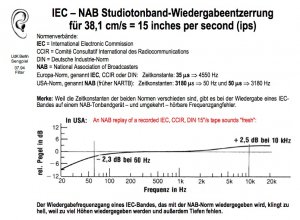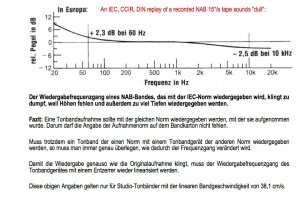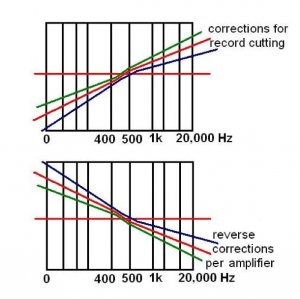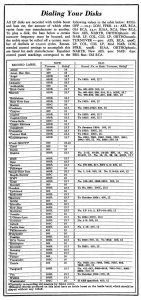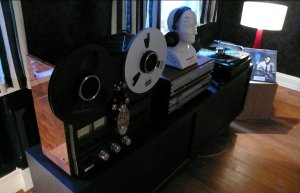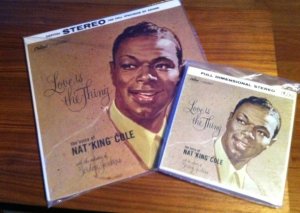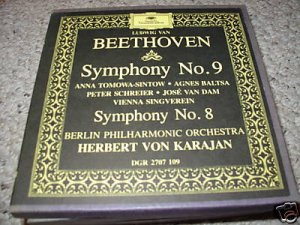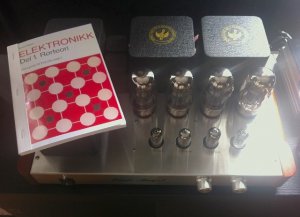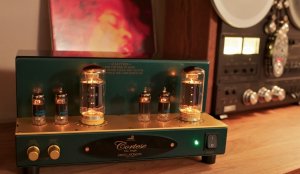Nat King Cole båndet er 11 år eldre enn Johnny Cash båndet vi lyttet til i går, og forskjellen i gjengivelse lot seg merke på noen punkter: det er mer tapesus på Nat King Cole, men slik at den ikke sjenerer når musikken kommer i gang, men den kan være ansvarlig for "bløtheten" vi mente å høre.
Tapen på Folsom Prison var tyst, både i forhold og faktisk. I tillegg hadde Cash det punchet som dukket opp i Gray/Hoffman versjonen av Love is the Thing på vinyl. Og slike dynamiske punch er jo best når de kommer fra sort bakgrunn, uten sus.
Det sies at høydepunktet for spolebånd faktisk kom etter at formatet var på vei ut, til "fordel" for musicassettes. Da var det en del selskap som inngikk avtaler med store distributører, og som begynte å gi ut spesialproduserte bånd. Utviklingen hadde gått nedoverbakke utover 60-tallet, ved at man først forlot 2-spors, for så å gå over til akselerert kopiering av 4-spors: dvs. ikke lenger 1:1 overspilling fra riktig avspillingshastighet, 8x helt opp til 32x var vanlig. Dette gjaldt spesielt for spolebånd med lavest avspillingshastighet, 9,53cm/sek. Og det var disse som dominerte på markedet, da man gikk over til musicassettes.
MC har enda lavere hastighet, 4,76cm/sek.
Firma som Barclay Crocker leverte toppkvalitet til seriøse audiofile, ved å tegne kontrakter med distributører av klassisk og jazz. Barclay Crocker overspilte fra masters, i 1:1 eller 4:1 og med Dolby B støyreduksjon og 19cm/sekund. Det finnes også 38cm/sek BC-bånd. De produserte for det meste 4-spors, men det finnes 2-spors BC-bånd. En komplett BC-samling består av over 700 spolebånd. Enkelte utgaver ble produsert i meget lave antall, til abonnenter.
Man ser hvilken distributør/plateselskap som har gjort innspillingen helt øverst:
Fra eBays info om BC:
The fastidious BARCLAY-CROCKER Reel to Reel Tape Company of Poughkeepsie, New York was internationally famous for manufacturing Reel to Reel tapes with a "no-holds-barred" attitude to quality. BARCLAY-CROCKER, (BC), carefully chose recordings for manufacturing only after critical evaluation of the MASTER TAPE supplied by the original licensing (record) company. After passing stringent BC standards, the record company master was painstakingly recorded 1-to-1 to a running master at 15 inches per second on 1/2 inch mastering tape and not subjected to any external limiting, compression or equalization. These new BC running masters were used to produce the LIMITED EDITION ISSUES (some less than ONE HUNDRED!) at tape recording speeds unheard of for the REEL TO REEL TAPE INDUSTRY.
Most commercially available Reel to Reel tapes in their day, were duplicated at very high speeds (60 -240 IPS) ranging from 8 to 32 times the tape's normal playing speed at 7 1/2 IPS or up to 64 times the speed of a 3 3/4 IPS tape! The BROAD-BANDWIDTH required at these high speeds severly taxes the amplifiers and heads of the duplicating equipment and adversely affects both the FREQUENCY RESPONSE and NOISE LEVEL of the duplicated tapes. BC's custom modified AMPEX DUPLICATING EQUIPMENT was set to operate at a ratio of only 4-to-1 (running master at 60 ips; recorded copies at 30 ips, or only 4 TIMES the normal playing speed of 7 1/2 ips). Because of this SLOW DUPLICATION speed, combined with the carefully made B-C running master and the use of the most expensive premium polyester-based, Audiotape Q-15, low noise tape they were able to produce a commercially available tape that captures the FULL RANGE, BRILLIANCE, and TONAL SUBTELTIES of the original master, far surpassing the ORIGINAL REEL TO REEL RELEASE by the record company (if one was even released)!!! The DOLBY B noise-reduction process was used on all but an select few recordings which were recorded processed to the DBX II standard (in extremely low quanities per selection).
For TEN glorious years (1977-1987) the BARCLAY-CROCKER CO painstakingly offered a product uniquely qualified to become bonafied exceptions to the limiting conditions which were then offered to the Reel To Reel listening public. To say that BC was the state-of-the-art source of it's day for reels is a cliched understatement. BC's very limited releases are simply extremely RARE EXAMPLES OF RECORDED MUSIC PERFECTION. And in time, the value, appreciation & desirability of these recordings will prove the axiom;
"If a man does not keep pace with his companions; perhaps it is because he hears a different drummer. Let him step to the music which he hears, however measured or far away". Henry David Thoreau (1817-1862).
WHAT DOES THE QUALITY CONTROL NUMBER ON THE BACK OF MY BC REEL MEAN???
KEY: The first number indicates the slave on which the tape was duplicated, the second the year (i.e. 9 for 1979, 0 for 1980, 4 for 1984), the next two numbers would be the month (08 would be August) and the final two numbers the day. The letters following the QC are the operator's initials. RF= Richard Fill, WC= Wayne Chin, EH = Erich Hissel and a few HBs = Henry Barclay! (Some tapes do not have operator numbers)!
More info:
Factory "Pre-Recorded" Open Reel (Reel To Reel) tapes made by most firms during their commercial success were duplicated at much higher speeds than the master tapes from which they were copied. Barclay-Crocker filled a demand created by audiophiles for higher quality copies, which were made at lower speeds and consequently higher quality. Most were encoded in Dolby B noise reduction and a few later titles were encoded in DBX II (DBX I was designed for 15 ips tapes, B-C was exclusively 7.5 ips). The firm reproduced commercial titles from several record labels during their all too-brief existence. Their releases, mostly classical, were generally accompanied by a nice text insert that described the work, composer, etc. Here is a nice example (PDF format). Production volumes varied from several hundred copies for most titles to fewer than 100 for some.
A unique feature of this firm's tapes is their use of Sonic Sentry, an audible signal that marked the beginning of the content of Side 1 on tapes whose content is significantly shorter on Side 1 than Side 2. They also used Dolby-level tones on all B-C Dolby tapes at the end of Side 1 and at the start of Side 2. These tones can be used to calibrate a Dolby unit, and for those who do not have a deck with automatic reverse, the Dolby tones are helpful as a reminder that the tape is about to run out. These topics and others are discussed in a text insert that is found in most Barclay-Crocker tapes.
And finally:
Beware of B-Cs transcribed in 1977 and 1978 (see above) on labels, Vanguard, Musical Heritage Society & Unicorn as there is a chance that they have lol problems (loss of lubricant). Before commiting to buy any of these, check refund policy of seller.



